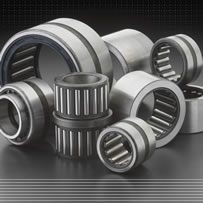Linear Roller Bearings

Linear roller bearings are designed to provide a linear contact patch. This means that the bearing's rollers are arranged in a line along the bearing's axis. This design provides a high load capacity and good rigidity. Because linear roller bearings have a small contact area, they are best suited for applications where the load is not very large, but where precision motion is required.
These bearings are made of many different materials, including steel, plastic, and ceramic. Steel linear roller bearings are most commonly used in steel industries due to their high strength, toughness, and durability. They can withstand high temperatures, high loads, and high speeds without overheating or wearing out quickly.
Steel Cylindrical Roller Bearings
Cylindrical roller bearings are another common type of roller bearing found in steel industries. They are designed with cylindrical rollers that are longer than their diameter. The length of the rollers allows them to support heavy loads and provide high radial rigidity.
These bearings are mostly used in applications where high radial loads are imposed. They are also suitable for applications where continuous operation is required. Steel cylindrical roller bearings can withstand high temperatures, corrosive environments, and high loads without losing their lubricant or causing excessive wear.
Tapered Roller Bearings
Tapered roller bearings are a type of roller bearing widely used in steel industries. They are designed with tapered rollers and raceways that are inclined at angles to the bearing's axis. This design provides high axial rigidity, high thrust capacity, and good stability.
These bearings are mostly used in applications that require both radial and axial loads. They are also suitable for applications that require high accuracy and precision. Steel tapered roller bearings are widely used in many industries due to their high strength, toughness, and reliability.
Spherical Roller Bearings
Spherical roller bearings are another type of roller bearing that is widely used in steel industries. They are designed with two rows of rollers that are arranged in a spherical shape. This design allows the bearing to compensate for misalignment, resulting in reduced stress on the bearing and extended service life.
These bearings are mostly used in applications where misalignment is expected or when mounting errors occur. They are also suitable for applications where a high load capacity is required. Steel spherical roller bearings are widely used in many industries because of their ability to withstand high temperatures, high speeds, and heavy loads.
Conclusion
Roller bearings are essential components in various industries, including steel industries, due to their ability to reduce friction and support moving parts. The most common types of roller bearings are linear, cylindrical, tapered, and spherical, each with their own set of advantages and disadvantages.
Steel roller bearings are widely used in steel industries because of their strength, toughness, and reliability. When selecting a roller bearing for your application, it is important to consider the load capacity, the operating environment, and precision requirements. By selecting the right roller bearing, you can improve equipment performance, reliability, and service life.